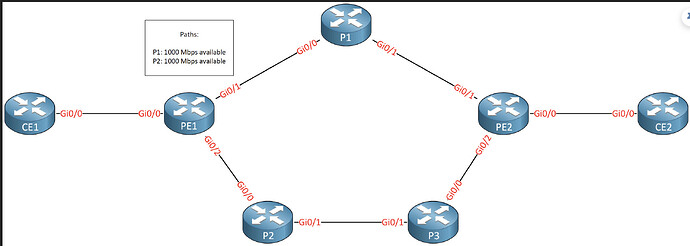This topic is to discuss the following lesson:
Hi everybody
I got an error that from tunnel1 and tunnel2
no routing dynamic
?
Hello Bahri
When it comes to MPLS TE, the dynamic nature of the setup means that dynamic routing protocols should be correctly enabled and configured, and that the tunnels be configured with the dynamic path-option like so:
PE1(config-if)#tunnel mpls traffic-eng path-option 1 dynamic
This will enable the tunnel path to dynamically conform to the path with the lowest metric based on the IGP deployed. For more info on this command, take a look at this Cisco command reference:
Now it seems that your error is showing that dynamic routing is somehow not enabled. In general, to resolve this error, you would need to:
- Ensure that a TE-aware routing protocol (like OSPF or IS-IS) is configured and operational.
- Check that the TE extensions are enabled for the routing protocol.
- Verify that the tunnels are configured to allow for dynamic routing.
Now without more information about your particular case, I can’t help you troubleshoot any further. Can you give us a little more context? When are you getting that error? When you apply a particular command or is it a syslog message that appears during the operation of the MPLS network? What are your config parameters? Let us know so that we can help you further.
I hope this has been helpful!
Laz
Dear team , bit confused about below scenario .I hope You guys can clear it.
Let’s assume there are two LLQs on P1’s Gi0/1 — LLQ priority level 1 for voice (300 kbps) and LLQ priority level 2 for video (400 kbps). In this case, how can I configure RSVP on all interfaces to have a global pool, a sub-pool, and tunnel bandwidth?
Hello Ratheesh
The scenario you refer to deals with DiffServ-aware Traffic Engineering for MPLS, or DS-TE MPLS. This is an enhancement to standard MPLS-TE. In MPLS-TE, you can reserve bandwidth for tunnels but all reservations come from the same single “global” bandwidth pool. This means that high-priority traffic (like voice or video) could be blocked if lower-priority tunnels have already consumed the available TE bandwidth.
DS-TE introduces the concept of multiple bandwidth pools, allowing you to create a global pool, as well as sub-pools. You can define multiple class types, wich for different categories of traffic. When this is done, RSVP knows whether it should take bandwidth from the global pool or the sub-pool based on the tunnel’s class-type.
Traditional MPLS DS-TE supports only a global pool, and a single sub-pool. To achieve what you are describing, you’d need to use MPLS DS-TE IETF mode. you can find out more about that at this lesson here:
This mode allows multiple sub-pools as you your scenario, and can support multiple class types as well as bandwidth constraints.
I hope this has been helpful!
Laz
